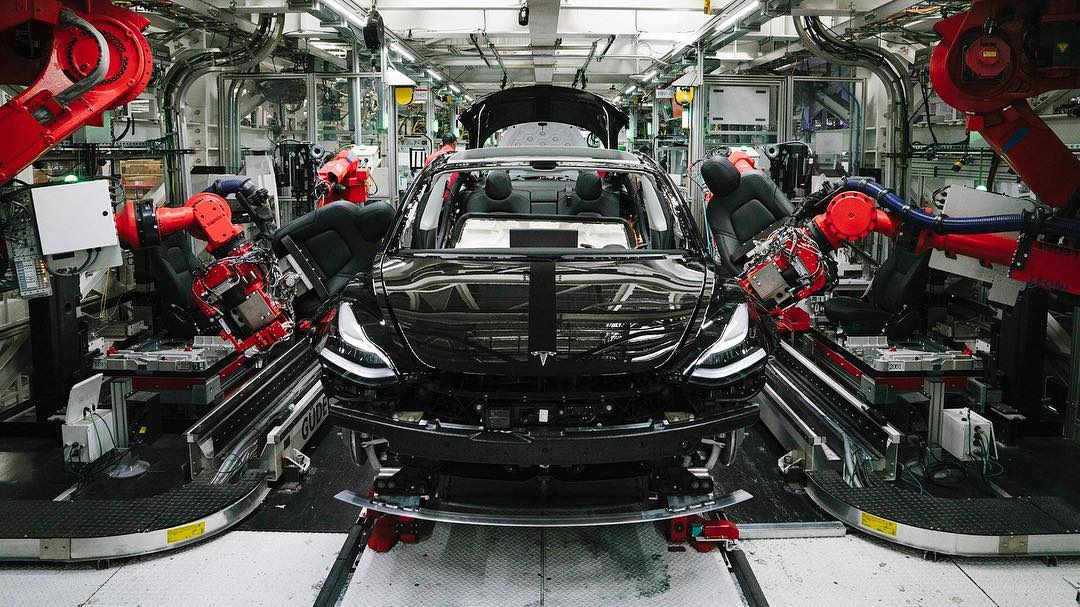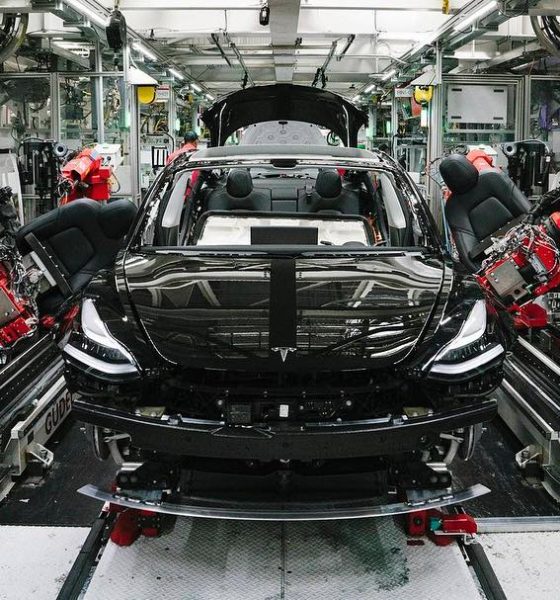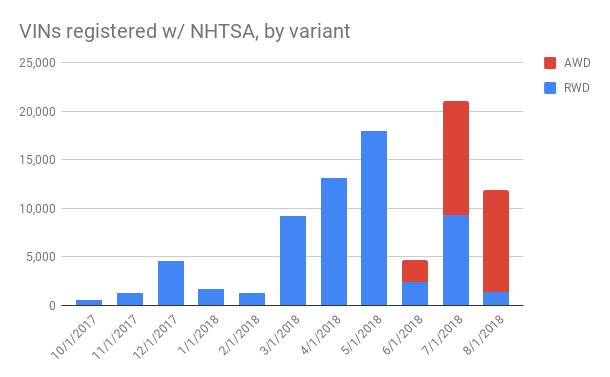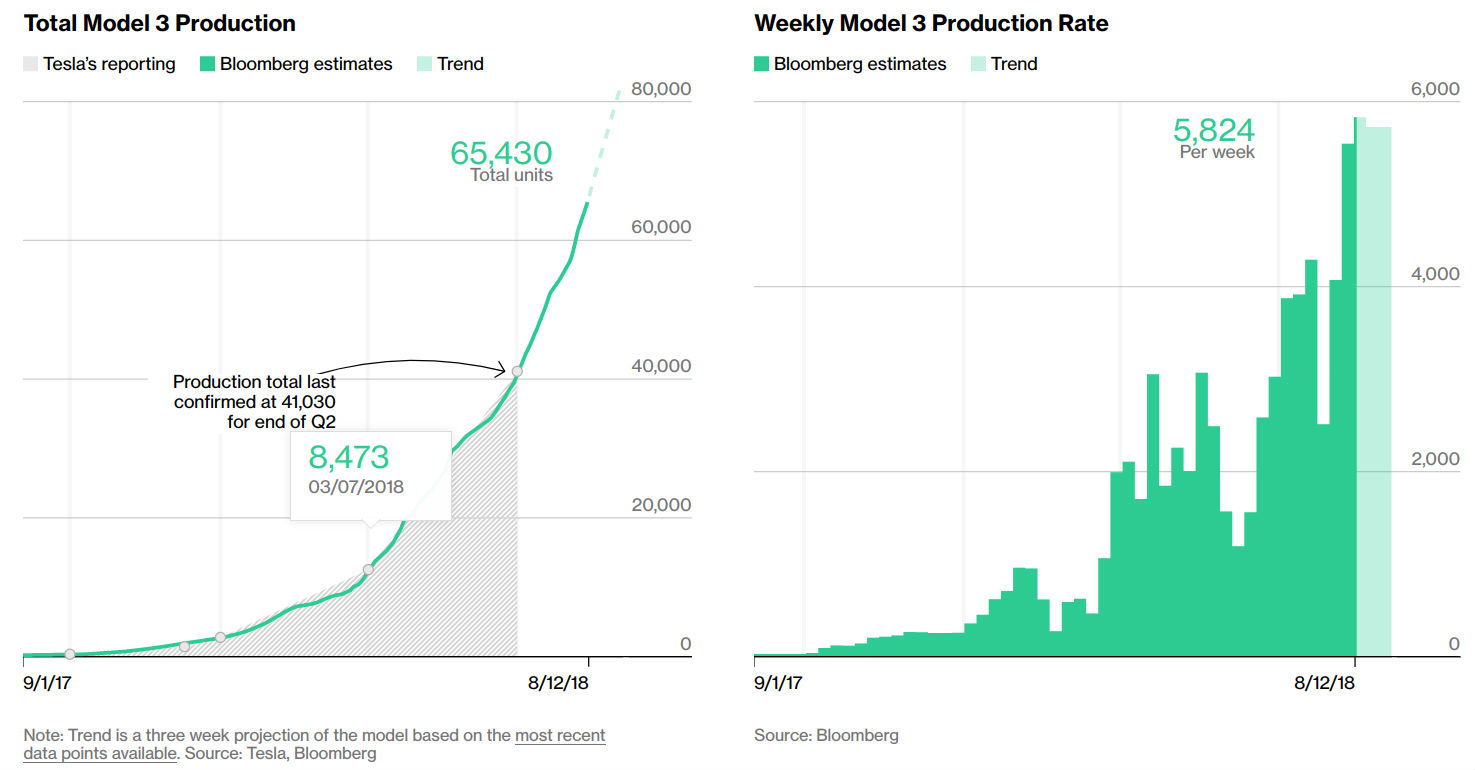

Investor's Corner
Tesla Model 3 ramp shows encouraging signs with 16k new VIN registrations in 7 days
Tesla has filed more than 16,000 new Model 3 VIN registrations in the past seven days, in what is yet another encouraging sign that the company is hitting its stride with the production of the electric car. Tesla has been working on sustaining the pace it displayed during its “burst production week” in the last seven days of June, when it manufactured 5,000 Model 3 in one week. These latest VIN registrations, together with updates from Tesla’s executives during the Q2 earnings call, indicate that Tesla is doing just that.
VIN registrations monitored by Twitter group @Model3VINs indicate that Tesla has filed multiple batches equaling more than 16,000 new Model 3 from August 5 to August 12. With the addition of small batches of new VINs this Sunday, Tesla has now registered a total of 98,254 Model 3 since the vehicle’s production started. Together with this notable ramp was an increase in filings corresponding to Dual Motor vehicles, which started picking up in July. Following is a graph showing the rise in Dual Motor VIN registrations as of August 1, 2018.

The Model 3 started production in mid-2017, but its ramp has been nothing but encouraging. When Elon Musk handed over the first 30 vehicles to employees in last year’s Model 3 Handover Party, Musk stated that Tesla would likely hit a production rate equal to 5,000 cars per week by the end of December 2017. Tesla was only able to attain this target on the final week of June 2018, and only by adopting unorthodox strategies such as air-freighting robots from Europe to the United States and building an entirely new assembly line inside a sprung structure on the grounds of the Fremont factory.
Since hitting its 5,000/week goal at the end of Q2, Tesla appears to have attained a breakthrough in the production of the Model 3. This week’s more than 16,000 new Model 3 VIN filings, for example, is roughly equal to the total VIN registrations in the first eight months of the vehicle’s production. VIN registrations over the past few months indicate that Tesla only breached the 16,000-vehicle mark near the end of March 2018.
Even Bloomberg‘s Model 3 production tracker, which has progressively increased its accuracy over the past few months (it was only 2% off Tesla’s actual numbers in Q2), now shows that the company is steadily approaching the 6,000 Model 3 per week mark. As of writing, the publication’s tracker estimates that Tesla is producing 5,824 Model 3 per week.

In Tesla’s Q2 2018 earnings call, Elon Musk stated that the company was able to sustain its optimum production pace during multiple weeks in July. Musk’s statement confirmed speculations last month that Tesla did not let up its push to manufacture the Model 3 at scale since hitting its production milestone at the end of June. These speculations were fueled by initiatives such as the start of test drive programs for the Model 3, a 5-Minute Sign & Drive program, and a ramp in the hiring of employees. The company also registered more than 19,000 new Model 3 VINs in the first two weeks of July.
The news coverage surrounding Tesla over the past week has been dominated by the possibility of the company going private when the stock hits $420 per share. But behind all this is one encouraging sign — the Model 3’s production ramp, which took almost a whole year to hit 5,000/week, finally seems to be going as planned.
Tesla has only released three versions of the Model 3 — the Performance, Dual Motor AWD, and the Long Range RWD variants — but the electric sedan has already made an impact in the US auto market. In July alone, the Model 3 ranked 7th overall in GoodCarBadCar‘s list of America’s Top 20 best-selling vehicles list, which includes popular gas-powered cars like the Toyota Camry and the Honda Accord.

Investor's Corner
Tesla stock closes at all-time high on heels of Robotaxi progress

Tesla stock (NASDAQ: TSLA) closed at an all-time high on Tuesday, jumping over 3 percent during the day and finishing at $489.88.
The price beats the previous record close, which was $479.86.
Shares have had a crazy year, dipping more than 40 percent from the start of the year. The stock then started to recover once again around late April, when its price started to climb back up from the low $200 level.
This week, Tesla started to climb toward its highest levels ever, as it was revealed on Sunday that the company was testing driverless Robotaxis in Austin. The spike in value pushed the company’s valuation to $1.63 trillion.
Tesla Robotaxi goes driverless as Musk confirms Safety Monitor removal testing
It is the seventh-most valuable company on the market currently, trailing Nvidia, Apple, Alphabet (Google), Microsoft, Amazon, and Meta.
Shares closed up $14.57 today, up over 3 percent.
The stock has gone through a lot this year, as previously mentioned. Shares tumbled in Q1 due to CEO Elon Musk’s involvement with the Department of Government Efficiency (DOGE), which pulled his attention away from his companies and left a major overhang on their valuations.
However, things started to rebound halfway through the year, and as the government started to phase out the $7,500 tax credit, demand spiked as consumers tried to take advantage of it.
Q3 deliveries were the highest in company history, and Tesla responded to the loss of the tax credit with the launch of the Model 3 and Model Y Standard.
Additionally, analysts have announced high expectations this week for the company on Wall Street as Robotaxi continues to be the focus. With autonomy within Tesla’s sights, things are moving in the direction of Robotaxi being a major catalyst for growth on the Street in the coming year.
Elon Musk
Tesla needs to come through on this one Robotaxi metric, analyst says
“We think the key focus from here will be how fast Tesla can scale driverless operations (including if Tesla’s approach to software/hardware allows it to scale significantly faster than competitors, as the company has argued), and on profitability.”

Tesla needs to come through on this one Robotaxi metric, Mark Delaney of Goldman Sachs says.
Tesla is in the process of rolling out its Robotaxi platform to areas outside of Austin and the California Bay Area. It has plans to launch in five additional cities, including Houston, Dallas, Miami, Las Vegas, and Phoenix.
However, the company’s expansion is not what the focus needs to be, according to Delaney. It’s the speed of deployment.
The analyst said:
“We think the key focus from here will be how fast Tesla can scale driverless operations (including if Tesla’s approach to software/hardware allows it to scale significantly faster than competitors, as the company has argued), and on profitability.”
Profitability will come as the Robotaxi fleet expands. Making that money will be dependent on when Tesla can initiate rides in more areas, giving more customers access to the program.
There are some additional things that the company needs to make happen ahead of the major Robotaxi expansion, one of those things is launching driverless rides in Austin, the first city in which it launched the program.
This week, Tesla started testing driverless Robotaxi rides in Austin, as two different Model Y units were spotted with no occupants, a huge step in the company’s plans for the ride-sharing platform.
Tesla Robotaxi goes driverless as Musk confirms Safety Monitor removal testing
CEO Elon Musk has been hoping to remove Safety Monitors from Robotaxis in Austin for several months, first mentioning the plan to have them out by the end of 2025 in September. He confirmed on Sunday that Tesla had officially removed vehicle occupants and started testing truly unsupervised rides.
Although Safety Monitors in Austin have been sitting in the passenger’s seat, they have still had the ability to override things in case of an emergency. After all, the ultimate goal was safety and avoiding any accidents or injuries.
Goldman Sachs reiterated its ‘Neutral’ rating and its $400 price target. Delaney said, “Tesla is making progress with its autonomous technology,” and recent developments make it evident that this is true.
Investor's Corner
Tesla gets bold Robotaxi prediction from Wall Street firm
Last week, Andrew Percoco took over Tesla analysis for Morgan Stanley from Adam Jonas, who covered the stock for years. Percoco seems to be less optimistic and bullish on Tesla shares, while still being fair and balanced in his analysis.

Tesla (NASDAQ: TSLA) received a bold Robotaxi prediction from Morgan Stanley, which anticipates a dramatic increase in the size of the company’s autonomous ride-hailing suite in the coming years.
Last week, Andrew Percoco took over Tesla analysis for Morgan Stanley from Adam Jonas, who covered the stock for years. Percoco seems to be less optimistic and bullish on Tesla shares, while still being fair and balanced in his analysis.
Percoco dug into the Robotaxi fleet and its expansion in the coming years in his latest note, released on Tuesday. The firm expects Tesla to increase the Robotaxi fleet size to 1,000 vehicles in 2026. However, that’s small-scale compared to what they expect from Tesla in a decade.
Tesla expands Robotaxi app access once again, this time on a global scale
By 2035, Morgan Stanley believes there will be one million Robotaxis on the road across multiple cities, a major jump and a considerable fleet size. We assume this means the fleet of vehicles Tesla will operate internally, and not including passenger-owned vehicles that could be added through software updates.
He also listed three specific catalysts that investors should pay attention to, as these will represent the company being on track to achieve its Robotaxi dreams:
- Opening Robotaxi to the public without a Safety Monitor. Timing is unclear, but it appears that Tesla is getting closer by the day.
- Improvement in safety metrics without the Safety Monitor. Tesla’s ability to improve its safety metrics as it scales miles driven without the Safety Monitor is imperative as it looks to scale in new states and cities in 2026.
- Cybercab start of production, targeted for April 2026. Tesla’s Cybercab is a purpose-built vehicle (no steering wheel or pedals, only two seats) that is expected to be produced through its state-of-the-art unboxed manufacturing process, offering further cost reductions and thus accelerating adoption over time.
Robotaxi stands to be one of Tesla’s most significant revenue contributors, especially as the company plans to continue expanding its ride-hailing service across the world in the coming years.
Its current deployment strategy is controlled and conservative to avoid any drastic and potentially program-ruining incidents.
So far, the program, which is active in Austin and the California Bay Area, has been widely successful.








